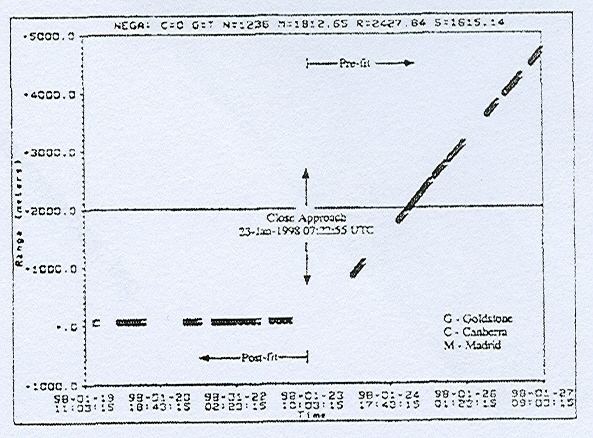 | ||
The flyby anomaly is an unexpected energy increase during Earth flybys of spacecraft. This anomaly has been observed as shifts in the S-band and X-band Doppler and ranging telemetry. Taken together, it causes a significant unaccounted velocity increase of up to 13 mm/s during flybys. Numerically larger discrepancies (400–1000 m) have been observed at least in one flyby (NEAR) against Space Surveillance Network (SSN) radars.
Contents
Observations
Gravitational assists are valuable techniques for Solar System exploration. Because the success of these flyby maneuvers depends on the geometry of the trajectory, the position and velocity of a spacecraft is continually tracked during its encounter with a planet by the Deep Space Network (DSN).
The flyby anomaly was first noticed during a careful inspection of DSN Doppler data shortly after the Earth flyby of the Galileo spacecraft on 8 December 1990. While the Doppler residuals (observed minus computed data) were expected to remain flat, the analysis revealed an unexpected 66 mHz shift, which corresponds to a velocity increase of 3.92 mm/s at perigee. Investigations of this effect at the Jet Propulsion Laboratory (JPL), the Goddard Space Flight Center (GSFC) and the University of Texas have not yielded a satisfactory explanation. No anomaly was detected after the second Earth flyby of the Galileo spacecraft in December 1992, where the measured velocity decrease matched that expected from atmospheric drag at the lower altitude of 303 km. However, the drag estimates had large error bars, and so an anomalous acceleration could not be ruled out.
On 23 January 1998 the Near Earth Asteroid Rendezvous (NEAR) spacecraft experienced an anomalous velocity increase of 13.46 mm/s after its Earth encounter. Cassini–Huygens gained around 0.11 mm/s in August 1999, and Rosetta gained 1.82 mm/s after its Earth flyby in March 2005.
An analysis of the MESSENGER spacecraft (studying Mercury) did not reveal any significant unexpected velocity increase. This may be because MESSENGER both approached and departed Earth symmetrically about the equator (see data and proposed equation below). This suggests that the anomaly may be related to Earth's rotation.
In November 2009, ESA's Rosetta spacecraft was tracked closely during flyby in order to precisely measure its velocity, in an effort to gather further data about the anomaly, but no significant anomaly was found.
The 2013 flyby of Juno on the way to Jupiter yielded no anomalous acceleration.
Summary of Earth-flyby spacecraft is provided in table below.
Future research
Upcoming missions with Earth flybys include BepiColombo with its launch due in October 2018 and its Earth flyby due April 2020.
Some missions designed to study gravity, such as STEP, will make extremely accurate gravity measurement and may shed some light on the anomaly.
Proposed equation
An empirical equation for the anomalous flyby velocity change was proposed by J. D. Anderson et al.:
where ωE is the angular frequency of the Earth, RE is the Earth radius, and φi and φo are the inbound and outbound equatorial angles of the spacecraft. This formula was derived later by Jean Paul Mbelek from the special relativity, leading to one of the possible explanations of the effect. This does not, however, consider the SSN residuals – see "Possible explanations" below.
Possible explanations
There have been a number of proposed explanations of the flyby anomaly, including:
